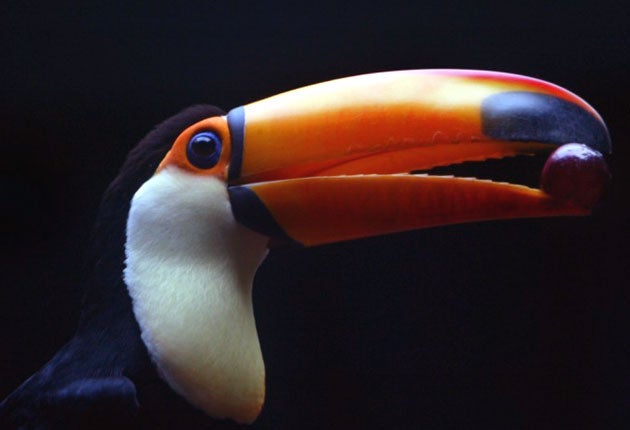Mystery of the toucan's beak solved

Charles Darwin thought the toucan's oversized beak was a sexual lure for attracting potential mates, while some modern-day biologists suggested it was either for peeling fruit or to warn off territorial rivals. A new study has found, though, that the outrageously big structure helps to keep the bird cool in the heat of the tropical day.
The beak of the toco toucan – the largest member of the toucan family – accounts for about one-third of the bird's body length, which is larger than the beak of any other bird for its size. When the 18th-century French naturalist Georges Louis Leclerc, the Compte de Buffon, first described the toucan he labelled its bill, "grossly monstrous".
Although no one has been able to come up with a satisfactory explanation of how the toucan acquired its beak, a team of scientists has been able to show that whatever purposes it may have originally served, it now helps to keep the bird cool, just like the oversized ears of the African elephant.
"Biologists all the way back to Darwin and even before have debated the purposes of the toucan's enormous beak," said Glenn Tattersall, an associate professor at Canada's Brock University in St Catherines, Ontario, who led the study published in the journal Science. "We found that basically the toucan's bill acts like a thermal window or thermal radiator that allows the bird to conserve or release heat, just like an elephant's ear."
A toucan's beak has a rich supply of blood vessels running along its surface so the bird's bill is suited to act as a means of radiating heat to keep the core temperature of the body stable – the bill also accounts of between 30 and 50 per cent of the bird's surface area.
The scientists monitored sleeping toucans with infra-red video cameras, enabling them to see how the surface temperature of the beak rose and fell during the night and as ambient air temperatures fluctuated. "We could tell whether the toucans were diverting warm blood to the beak and thus having the surface temperature warm up, or whether they were restricting blood to the bill and therefore allowing the bill to remain cooler," Dr Tattersall said.
They found that the toucan's bill in the heat of the day was up to 10C warmer than at sunset. The birds appear to be able to alter the blood flow to their beaks to control the amount of heat being lost or conserved.
Because toucans, like other birds, cannot sweat, this would be a useful way of controlling body temperature. The scientists calculate that the toucan is able to lose as much as four times its resting heat production through its beak – considerably more efficient than the elephant's ear.
Join our commenting forum
Join thought-provoking conversations, follow other Independent readers and see their replies
Comments